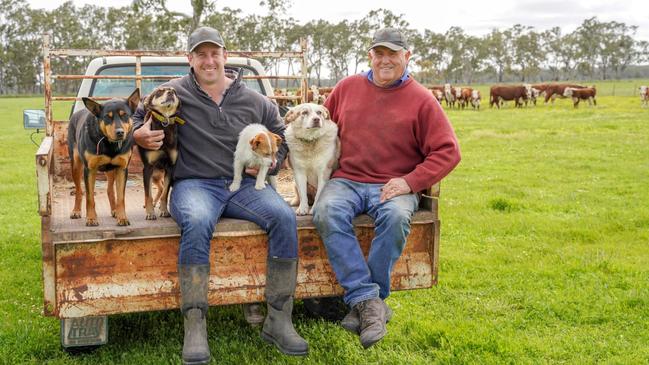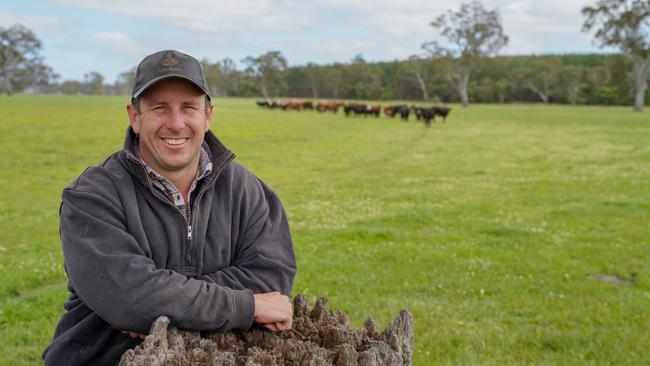Black baldies boost Lake Mundi beef business
New calving times and an improved feed base are among the winning ways for a western Victorian beef and sheep enterprise.

THE Stark family can trace their farming roots back to the late 1800s when their Scottish forebears began farming the fertile, high-rainfall land around Lake Mundi, between Casterton and Penola in western Victoria’s border country.
But tradition has not held the family back from developing their business.
With an aerospace engineer-qualified son who has returned home to the Blink Bonnie business, the family continue to make decisions to better match their enterprises to demands of today’s consumers.
Such as making the switch from decades of breeding white-faced cattle to black baldies, in pursuit of producing better eating- quality red meat.
This is one of several changes the family have made as they continue to strive to produce food as efficiently and effectively as possible.
Another has been moving calving times to better suit the feed curve, cutting and feeding out less hay and changing the way they use their available irrigation to finish more livestock to killable weights on-farm, instead of supplying the traditional summer weaner calf sales.
Kevin and Maryanne Stark run the 2500ha farm along with son Kevin Jnr, one of five adult children.
When Kevin Jr returned home to the farm they ran Corriedale and Comeback sheep alongside Hereford cattle.
The high-rainfall property, which has grown with recent additions, receives most of its 710mm annual rainfall in winter and spring.
“We used to get a lot of summer rain, but the past five years have been a lot drier,” Kevin Jr said.
Soil types range from heavy black clays to red gum sandy loams and about 400ha is irrigated.
HAVING A PEAK
THE Starks recently moved away from irrigating hay toward running and finishing more of their own cattle on irrigated pastures, and increasing silage production.
The family recently bought about 1100ha of neighbouring land and also have a property further south at Heywood, where they run steers.
“Ten years ago we thought land prices peaked then, when the bluegum industry came through, but of course now they’ve gone much higher again, so where they’ll peak, we don’t know,” Kevin Snr said.
“It would have been good to have a crystal ball five years ago.”
Kevin Jr, 31, said he always planned on coming home, but first wanted to go to university and travel.
This took him to study aerospace engineering in Melbourne and 12-month internship in Germany.
He has four siblings and all maintain an interest in the farm; Wal, Felicity, Claire and Francis, who works as an analyst for JBS Australia in Melbourne.
The operation is now more focused on cattle than sheep but the aim was to “even that up a bit”.
“Before I came home things were transitioning from selling weaners to growing everything out to kill weights and by doing that we could better use the irrigation,” Kevin Jr said.
“We have been an autumn-calving herd, but have moved that back towards May now and started a second calving in winter-spring, July-August.”
The plan is to now move all calving into winter-spring.
“That will better fit our feed growth curve, so we can run the cows a lot tighter, pull the calves off and leave the cows in good condition,” he said.
“The cows then run themselves, now, we feed a power of feed out to our autumn-calvers, through those tough months.
“We can use the irrigation better now. It will reduce our hay; time and costs and the calves do exceptionally well.”
Calves born August-September are now weaned in January to March.
FEED FORAY
ANOTHER area the Starks are looking to change is the feed base.
“We’re trialling different feed crops to fill feed gaps,” Kevin Jnr said.
The dryland pasture is phalaris based, while the irrigated country, around 400ha is under pivot and flood irrigation with pastures mainly made up of rye-grass, clovers and lucerne.
“We’re going to go back to lucerne more to spread out the later growth and it is more water efficient,” he said.
“In the winter we’ll trial cereal, ryegrass mix and a fodder beet; it’s an expensive crop to put in, but if we get it right it will provide a phenomenal amount of feed from March to June, which would be really handy.”
This year the family hoped to do more silage for spring-calving weaners, and cut less hay, as the herd transitioned towards spring calving.
Kevin Jr said the change had meant they needed to be strict on low birth-weight bulls for calving heifers, to avoid large calves.
The herd is 800 cows and the base is Hereford, but the family is shifting towards crossbreeding instead as they found the whiteface genetics not keeping up with consumer demand for intramuscular fat.
“We’ve been using black bulls over heifers for a few years and started buying in black cow bulls two years ago,” Kevin Jr said.
“At the moment we are heading down the black baldy line.
“We’re not 100 per cent sure, but thinking we might try to keep a crossbreeding herd going.”

The decision to move to black baldies after many years as a Yarram Park and Injemira bloodline Hereford and Poll Hereford herd was “a bit controversial”, Kevin Jr said, but the advantages of crossbreeding were convincing.
Recently they have been using Angus bulls from Dunoon, Rennylea, Boonaroo and Barwidgee studs.
“They both have advantages. We find Herefords have great weight-for age and growth, but the JBS feedback we get shows we battle on IMF,” he said.
“With the blacks you can bring in IMF and polled genetics much quicker.
“Also, if the season cuts out and you need to sell feeders steers, this year for example the grids give you around 20c/kg more for blacks.
“The black baldy cow is a very good animal and, for example, when we’re selling 60 steers, 99 per cent of the time the black baldies are finished first.”
Finished cattle are sold to JBS through its Great Southern accredited grass-fed program.
“We find our cattle kill well there, we find them good to deal with and the feedback is good,” Kevin Jr said.
“We get the MSA kill data back and once a year they (JBS) come out and we look at how we stack up against other producers in a constructive way.”
Kevin Jr said this had led to a greater emphasis on IMF and fat in their genetic selections, pushing towards a higher Meat Standards Australia index and premium products.
“We go to several studs, we don’t just stock to one, so that gives us the ability to target the genetics we need and work within our budget,” he said.
Kevin Jr said it was “early days yet. but we hope to see an improvement in our MSA data and decrease how many fall out of MSA compliance.
“We aim to turn off as many as we can by about two years- old, weighing 340-360kg carcass weight,” he said. “Spring-drop calves are getting there quicker.”
GOOD TRADE-OFF
WHILE the cattle enterprise is mostly breeding, some lambs are traded in if conditions permit.
The family run 2500 ewes, buying in first-cross and composites, turning off supermarket-weight lambs, starting selling at Christmas time – ideally targeting the price premiums often available then — and buy in further lambs afterwards.
“But if we can avoid weaning them we will,” he said. “With the irrigation we are not forced to sell at certain times.”
Poll Dorset and White Suffolk rams are used and the Starks are now breeding their own flock rams.
“I enjoy breeding rams and the economics stack up,” Kevin Jr said.
Depending on the season some lambs are weaned and they go onto pastures under pivots.
This year they achieved the best average of 140 per cent lambmarking percentage, thanks to a relatively mild winter.
The Starks sell direct with the cattle and use the services of a livestock agent with the lambs.
Looking at livestock prices, Kevin Sr said he has been happily surprised that COVID-19 did not create a downturn.
The Starks also do some share farming to produce potatoes and cereal crops, which is another risk management tool.
Kevin Jnr said the biggest challenge was evening out the growth and pasture usage through the year.
Wet winters were difficult, Kevin Sr said.
“We are limited by our winter,” he said.
He said overheads such as rising rate bills, were also a significant challenge for all Victorian farm businesses, and one that urgently needed addressing.
Other production improvements will include a move to more rotational grazing, as the feed base and grazing patterns change in response to the switch in calving times.
Like many farming families the Starks all pitch in, with no set roles. The family do the work themselves, using contractors for sheep work.
Looking forward, Kevin Jr said further land purchases would also be an option, along with a boost to stock numbers.
“I like the challenge of running your own business and having the goal of growing,” he said. “Hopefully within five years we will have expanded again, be running more stock and have improved pastures.
“I think that will come with the spring calving.”
MORE
ASTONISHING CATTLE PRICES FORECAST, BUT THEN WHAT?
ANIMAL WELFARE ACTIONS RAISE PRODUCTIVITY, SUSTAINABILITY
VICTORIAN FARMERS FEDERATION 2020 PRESIDENTIAL ELECTION: EMMA GERMANO VS LEONARD VALLANCE


